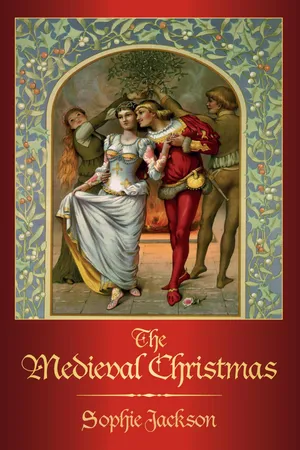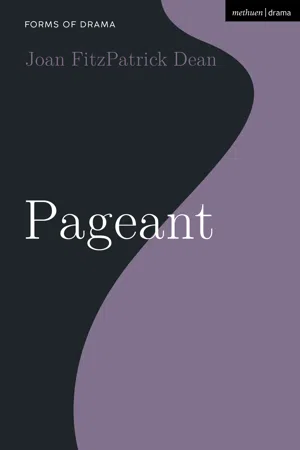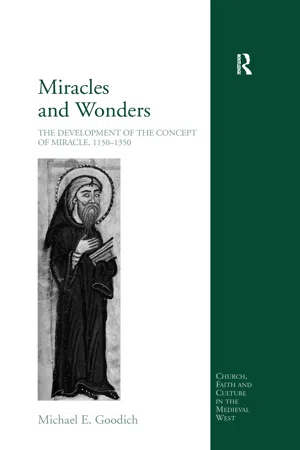Miracle Plays
Miracle plays are medieval religious dramas that depict the lives of saints and biblical events. They were performed in public spaces and were a popular form of entertainment and religious instruction in Europe during the Middle Ages. These plays often featured spectacular special effects and were performed by members of the local community.
3 Key excerpts on "Miracle Plays"
- eBook - ePub
- Sophie Jackson(Author)
- 2013(Publication Date)
- The History Press(Publisher)
...Chapter One Mummers, Mysteries and Miracles The History of Mystery and Miracle Plays The medieval mystery and Miracle Plays performed at Christmas re-enacted Bible stories and were among some of the most popular entertainments of the Christmas season. They were probably based on an earlier form of religious theatre, the liturgical drama that first appeared in the tenth and eleventh centuries as a means of helping ordinary people learn biblical tales, consisting of very short plays in the vernacular as well as Latin, which gave the common man a chance to understand what was happening. These early medieval plays were originally performed by monks, but problems soon arose with some of the subjects; for instance, the story of the Massacre of the Innocents posed the question of whether it was right for a monk to represent the evil King Herod. Was it even spiritually sound to portray such a vile act within the walls of a church? The liturgical dramas never went further than the original few short lines, but they served to open up a whole new dimension of entertainment. Secular performers had already started to develop new plays, so the atmosphere was ripe for the mystery and Miracle Plays to flourish. As far as we know, the oldest such play was written by Abbot Geoffrey of St Albans in 1110. Taking St Katherine as its subject, it was performed in Dunstable, where the Abbot taught. In the years that followed, many mystery and Miracle Plays were created, and eventually the whole story of the Bible – from the Creation to Christ’s crucifixion and resurrection and, finally, Doomsday – was enacted. The difference between the two types of play was that the mysteries described the stories of the Old and New Testaments, including those of Cain and Abel, Noah’s flood and the Nativity. The miracles, on the other hand, told of the lives of the saints...
- eBook - ePub
- Joan FitzPatrick Dean, Simon Shepherd(Authors)
- 2021(Publication Date)
- Methuen Drama(Publisher)
...They were performed in churches and palaces, streets, squares and graveyards. They might be staged in a single (often indoor) location; in a processional or stational model or on a multiple fixed-location set. (1997: 45) Eamon Duffy points to the increasing literacy, even among women, as “the crucial factor in the growth of a well-instructed laity in fifteenth-century England” (2006: 68). In consequence, the circulation of religious texts “brought religious instruction out of the church, into the household and the gildhall and thereby into direct competition with secular entertainment” (69). From the thirteenth century, many northern European cities and towns used pageants to impart a knowledge of the tenets of Christian faith to a population that overwhelmingly lacked formal schooling. From the twelfth century, medieval Christian drama developed in several directions. The most common classifications differentiate liturgical plays, mystery cycles, moralities, and Miracle Plays. Alexandra F. Johnston, however, points out that “the biblical plays were part of the intricate cultural tapestry of the liturgy, the non-dramatic literature, the art and the ceremony of late medieval England” (2017: 187). These theatrical and para-theatrical forms held the potential for spectacle, and pageants were at the heart of many of these. Miracle Plays, for instance, present arresting episodes from the lives of St. Ursula, St. George, or Mary Magdalene...
- eBook - ePub
Miracles and Wonders
The Development of the Concept of Miracle, 1150-1350
- Michael E. Goodich(Author)
- 2017(Publication Date)
- Routledge(Publisher)
...Those with access to canonization documents made use of these sources in the preparation of the sermon. Nevertheless, a certain inconsistency characterized the work of the preachers and hagiographers. While evidence of the miraculous pervaded both the saint's earthly and posthumous life as reported in the standard Vita et miracula and was necessary to confirm the public perception of holiness, the summarized version found in the sermon clearly de-emphasized the role of the supernatural, except in rare instances such as the sermons of Pope Clement VI. Thus, the scholastic theologians had produced a systematic theology of miracle that was given a more public voice in the flourishing sermon literature of the period. This theology of the miracle, based on Augustinian foundations and its application in canon law, continued in the fourteenth century, when procedural and structural recording of the miracle, whether under local or papal auspices, was refined, often under the expert guidance of notaries who were active in both ecclesiastical and secular courts. The miracle acquired a fixed form which satisfied certain uniform literary, theological and legal standards which made it amenable to comparative analysis; and which permitted those entrusted with distinguishing questionable from genuine instances of divine intervention to reach a rational conclusion. Paradoxically, while the raw material of the miracle story had often been the transcendent experience of the unlettered, this resource was summarized, classified, organized, judged, and retransmitted to the unschooled by learned hagiographers and preachers as a means of cementing the lessons of the Faith. In this repackaged form the miracle reached the believers through sermons, liturgy and visual art. 89 Nevertheless, in the ‘higher culture’ of the preacher's podium, the miracle was subordinated to the virtues of the saint...


